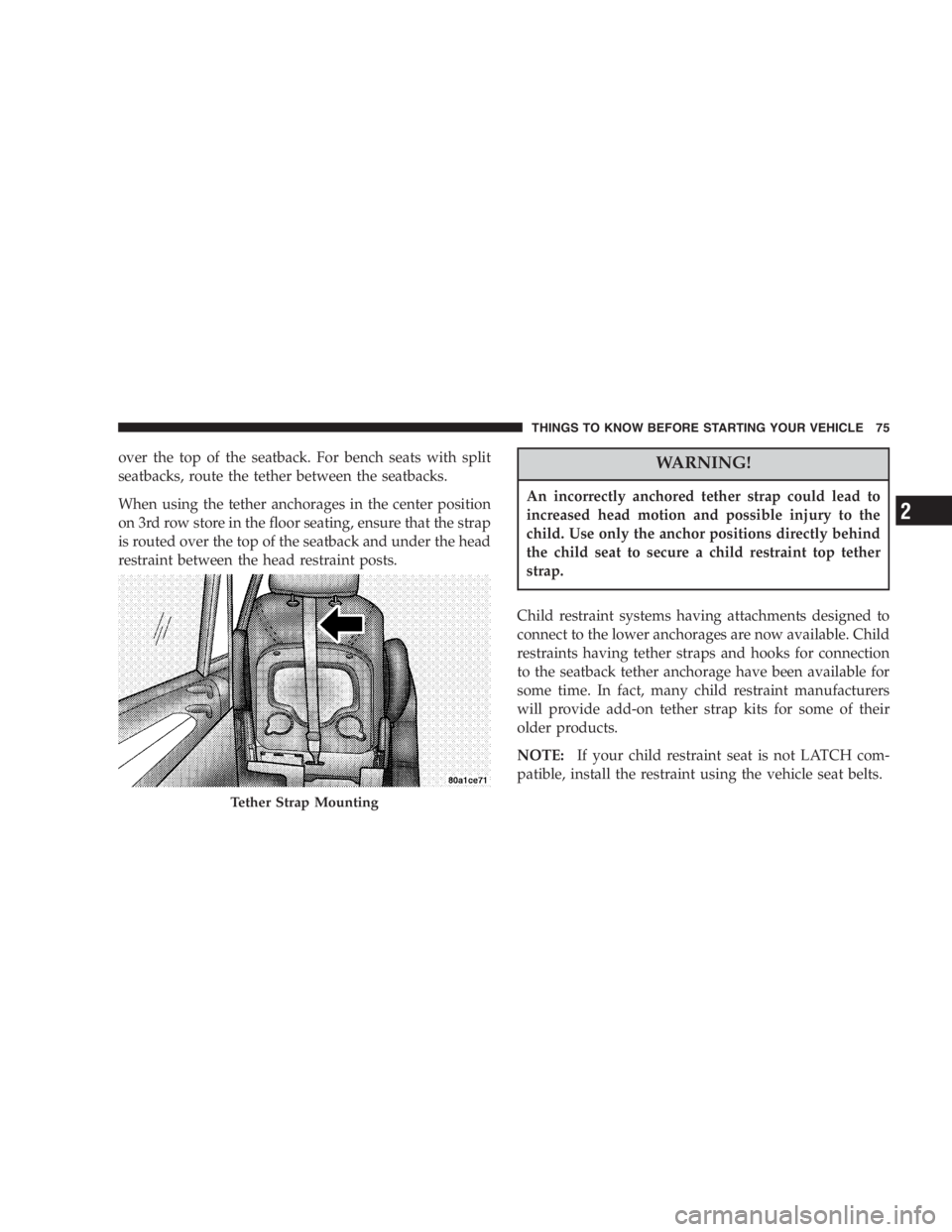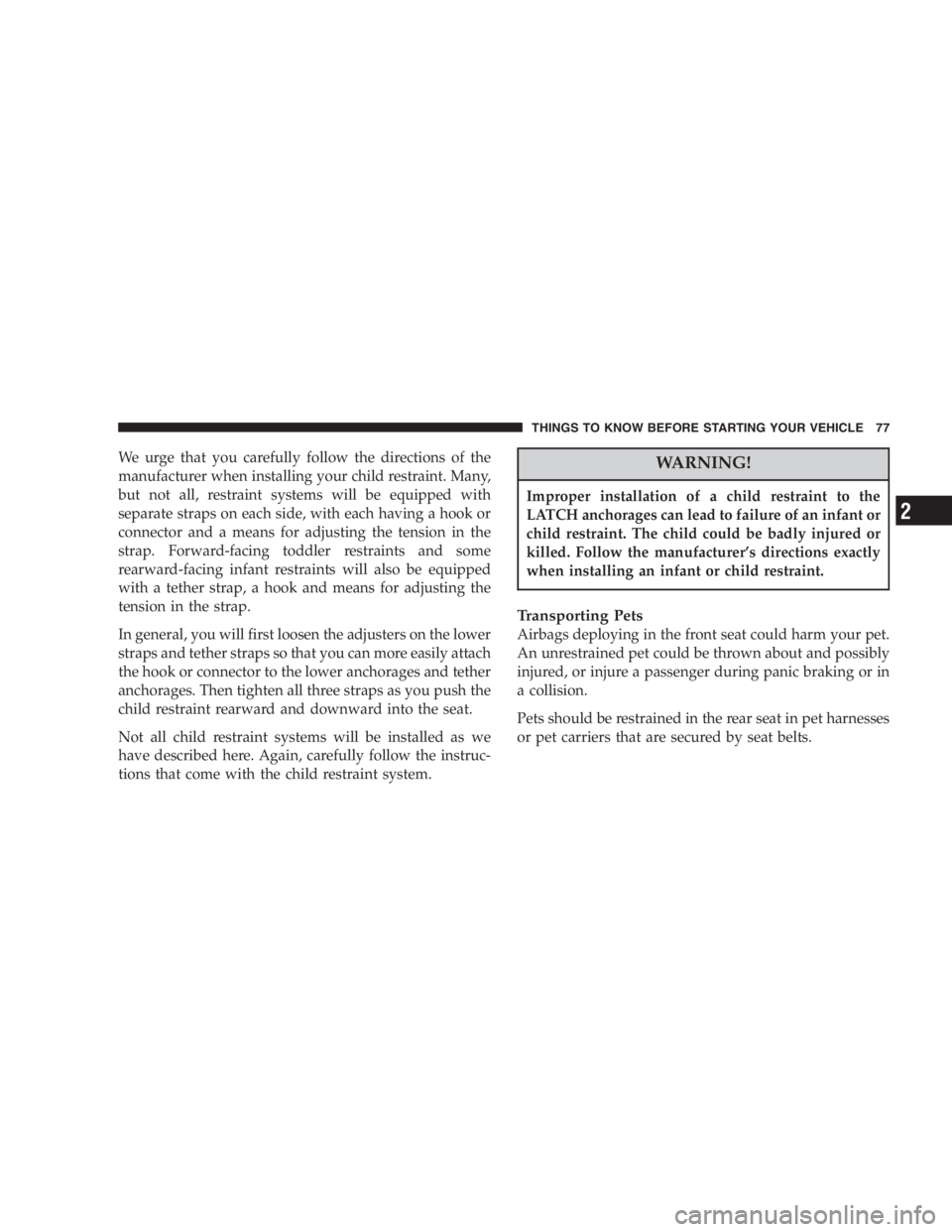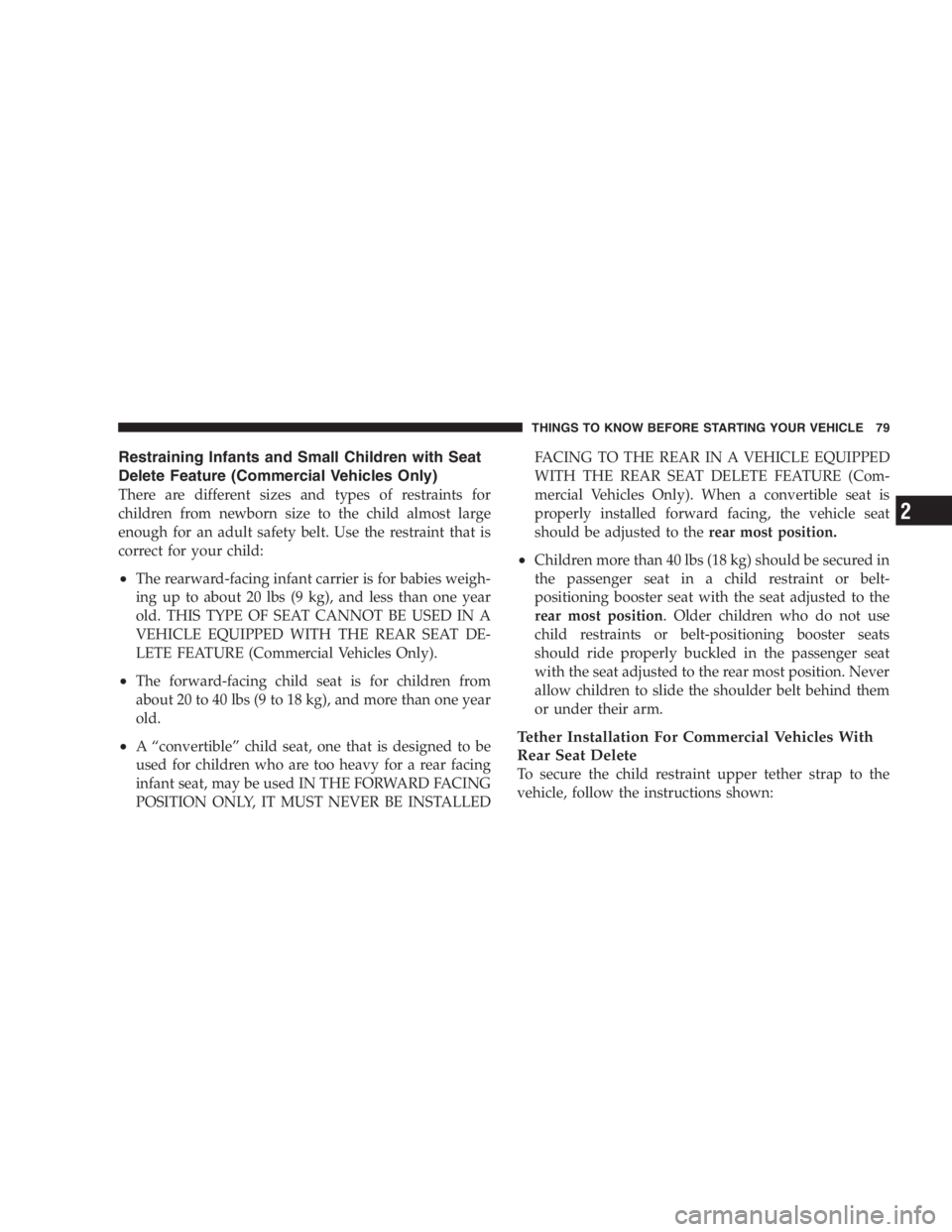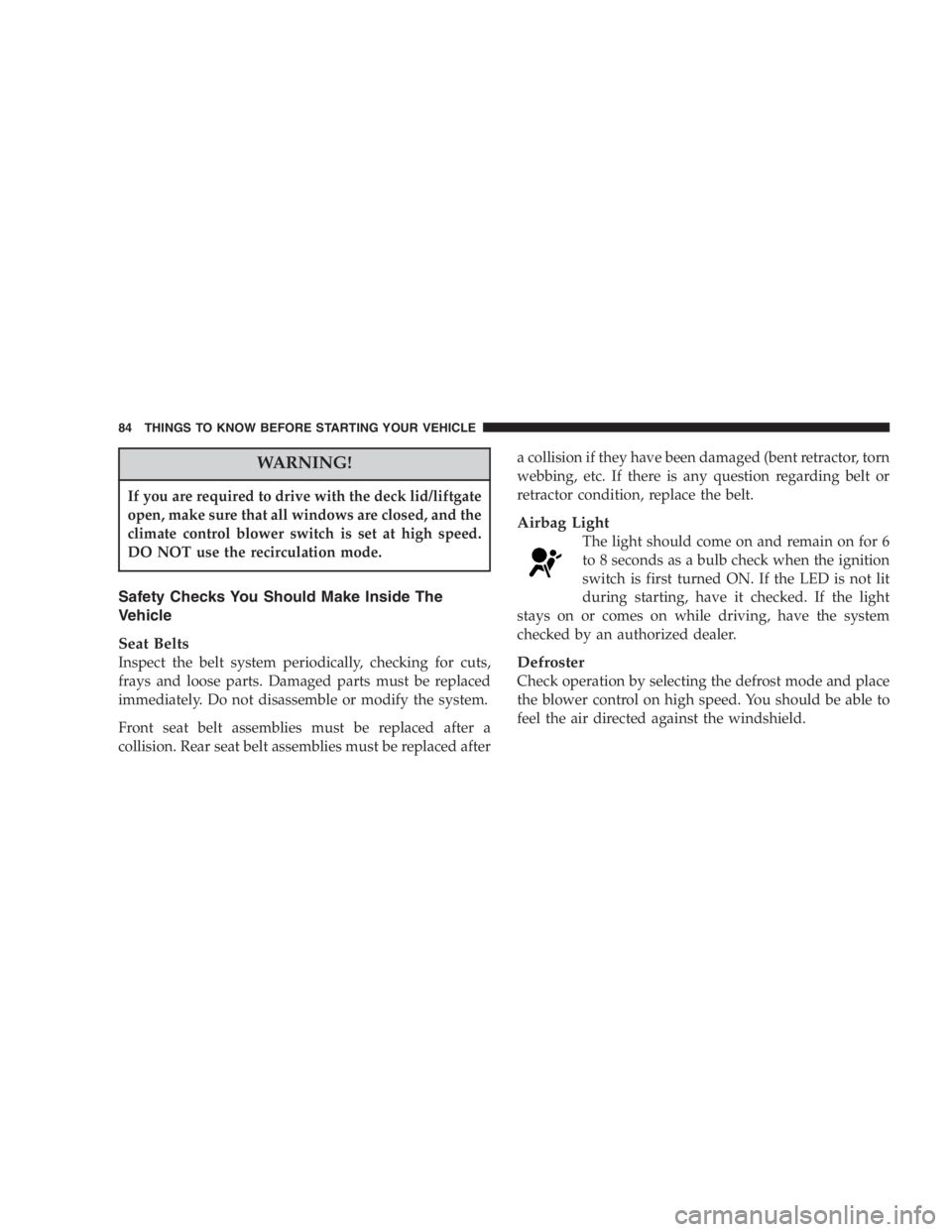Page 73 of 480

The passenger seat belts are equipped with cinching
latch plates, which are designed to keep the lap
portion tight around the child restraint so that it is not
necessary to use a locking clip. Pulling up on the
shoulder portion of the lap/shoulder belt will tighten
the belt. The cinching latch plate will keep the belt
tight, however, any seat belt system will loosen with
time, so check the belt occasionally and pull it tight if
necessary.
• In the rear seat, you may have trouble tightening the
lap/shoulder belt on the child restraint because the
buckle or latch plate is too close to the belt path
opening on the restraint. Disconnect the latch plate
from the buckle and twist the short buckle end of the
belt several times to shorten it. Insert the latch plate
into the buckle with the release button facing out. • If the belt still can ’ t be tightened, or if pulling and
pushing on the restraint loosens the belt, disconnect
the latch plate from the buckle, turn the buckle
around, and insert the latch plate into the buckle
again. If you still can ’ t make the child restraint secure,
try a different seating position.
• Buckle the child into the seat according to the child
restraint manufacturer ’ s directions.
• When your child restraint is not in use, secure it in the
vehicle with the seat belt or remove it from the vehicle.
Don ’ t leave it loose in the vehicle. In a sudden stop or
collision, it could strike the occupants or seatbacks and
cause serious personal injury. THINGS TO KNOW BEFORE STARTING YOUR VEHICLE 73
2
Page 75 of 480

over the top of the seatback. For bench seats with split
seatbacks, route the tether between the seatbacks.
When using the tether anchorages in the center position
on 3rd row store in the floor seating, ensure that the strap
is routed over the top of the seatback and under the head
restraint between the head restraint posts. WARNING!An incorrectly anchored tether strap could lead to
increased head motion and possible injury to the
child. Use only the anchor positions directly behind
the child seat to secure a child restraint top tether
strap.
Child restraint systems having attachments designed to
connect to the lower anchorages are now available. Child
restraints having tether straps and hooks for connection
to the seatback tether anchorage have been available for
some time. In fact, many child restraint manufacturers
will provide add-on tether strap kits for some of their
older products.
NOTE: If your child restraint seat is not LATCH com-
patible, install the restraint using the vehicle seat belts.Tether Strap Mounting THINGS TO KNOW BEFORE STARTING YOUR VEHICLE 75
2
Page 76 of 480

Fleet vehicles equipped with the LATCH system on the
3-passenger bench seat must have the seat adjusted to the
full rear position on the tracks when the LATCH system
is used. Also, when using the LATCH system, be sure the
seatback is two clicks rear of its full upright position.
Because the lower anchorages are to be introduced to
passenger carrying vehicles over a period of years, child
restraint systems having attachments for those anchor-
ages will continue to have features for installation in
vehicles using the lap or lap/shoulder belt. They will also
have tether straps, and you are urged to take advantage
of all of the available attachments provided with your
child restraint in any vehicle. Installing the Child Restraint System
If your fleet vehicle is equipped with LATCH anchorages
on the 3-passenger bench seat, do not install three child
restraints at the same time in this seat. The anchorages in
this seat are not designed to restrain three child restraints
at one time. Instead, you may install one child restraint at
the center position, or one child restraint at each of the
right and left positions.
WARNING!Fleet Vehicles Only:
Do not install child restraint systems equipped with
LATCH attachments at all three seating positions in
the seat at one time. The LATCH anchorages in this
seat are designed to restrain no more than two child
restraints at a time in the event of a collision. Failure
to follow this may result in serious or fatal injury.76 THINGS TO KNOW BEFORE STARTING YOUR VEHICLE
Page 77 of 480

We urge that you carefully follow the directions of the
manufacturer when installing your child restraint. Many,
but not all, restraint systems will be equipped with
separate straps on each side, with each having a hook or
connector and a means for adjusting the tension in the
strap. Forward-facing toddler restraints and some
rearward-facing infant restraints will also be equipped
with a tether strap, a hook and means for adjusting the
tension in the strap.
In general, you will first loosen the adjusters on the lower
straps and tether straps so that you can more easily attach
the hook or connector to the lower anchorages and tether
anchorages. Then tighten all three straps as you push the
child restraint rearward and downward into the seat.
Not all child restraint systems will be installed as we
have described here. Again, carefully follow the instruc-
tions that come with the child restraint system. WARNING!Improper installation of a child restraint to the
LATCH anchorages can lead to failure of an infant or
child restraint. The child could be badly injured or
killed. Follow the manufacturer ’ s directions exactly
when installing an infant or child restraint.
Transporting Pets
Airbags deploying in the front seat could harm your pet.
An unrestrained pet could be thrown about and possibly
injured, or injure a passenger during panic braking or in
a collision.
Pets should be restrained in the rear seat in pet harnesses
or pet carriers that are secured by seat belts. THINGS TO KNOW BEFORE STARTING YOUR VEHICLE 77
2
Page 79 of 480

Restraining Infants and Small Children with Seat
Delete Feature (Commercial Vehicles Only)
There are different sizes and types of restraints for
children from newborn size to the child almost large
enough for an adult safety belt. Use the restraint that is
correct for your child:
• The rearward-facing infant carrier is for babies weigh-
ing up to about 20 lbs (9 kg), and less than one year
old. THIS TYPE OF SEAT CANNOT BE USED IN A
VEHICLE EQUIPPED WITH THE REAR SEAT DE-
LETE FEATURE (Commercial Vehicles Only).
• The forward-facing child seat is for children from
about 20 to 40 lbs (9 to 18 kg), and more than one year
old.
• A “ convertible ” child seat, one that is designed to be
used for children who are too heavy for a rear facing
infant seat, may be used IN THE FORWARD FACING
POSITION ONLY, IT MUST NEVER BE INSTALLED FACING TO THE REAR IN A VEHICLE EQUIPPED
WITH THE REAR SEAT DELETE FEATURE (Com-
mercial Vehicles Only). When a convertible seat is
properly installed forward facing, the vehicle seat
should be adjusted to the rear most position.
• Children more than 40 lbs (18 kg) should be secured in
the passenger seat in a child restraint or belt-
positioning booster seat with the seat adjusted to the
rear most position . Older children who do not use
child restraints or belt-positioning booster seats
should ride properly buckled in the passenger seat
with the seat adjusted to the rear most position. Never
allow children to slide the shoulder belt behind them
or under their arm.
Tether Installation For Commercial Vehicles With
Rear Seat Delete
To secure the child restraint upper tether strap to the
vehicle, follow the instructions shown: THINGS TO KNOW BEFORE STARTING YOUR VEHICLE 79
2
Page 84 of 480

WARNING!If you are required to drive with the deck lid/liftgate
open, make sure that all windows are closed, and the
climate control blower switch is set at high speed.
DO NOT use the recirculation mode.
Safety Checks You Should Make Inside The
Vehicle
Seat Belts
Inspect the belt system periodically, checking for cuts,
frays and loose parts. Damaged parts must be replaced
immediately. Do not disassemble or modify the system.
Front seat belt assemblies must be replaced after a
collision. Rear seat belt assemblies must be replaced after a collision if they have been damaged (bent retractor, torn
webbing, etc. If there is any question regarding belt or
retractor condition, replace the belt.
Airbag Light
The light should come on and remain on for 6
to 8 seconds as a bulb check when the ignition
switch is first turned ON. If the LED is not lit
during starting, have it checked. If the light
stays on or comes on while driving, have the system
checked by an authorized dealer.
Defroster
Check operation by selecting the defrost mode and place
the blower control on high speed. You should be able to
feel the air directed against the windshield.84 THINGS TO KNOW BEFORE STARTING YOUR VEHICLE
Page 108 of 480
Using body pressure, move forward and rearward on the
seat to be sure the seat adjusters have latched.
WARNING!Adjust the seat only while the vehicle is parked.
Adjusting a seat while the vehicle is moving is
dangerous. The sudden movement of the seat could
cause you to lose control. The seat belt might not be
properly adjusted and you could be injured.
8 – Way Driver ’ s Power Seat — If Equipped
The driver ’ s power seat switches are located on the
outboard side of the seat. The front switch controls
up/down, forward/rearward, and tilt adjustment. The
rear switch controls the seatback recline adjustment. 4 – Way Passenger ’ s Power Seat — If Equipped
The passenger ’ s power seat switches are located on the
outboard side of the seat. The front switch controls
forward and rearward adjustment. The rear switch con-
trols the seatback recline adjustment. Driver Power Seat Switches108 UNDERSTANDING THE FEATURES OF YOUR VEHICLE
Page 111 of 480
seatback to its normal position. Using body pressure, lean
forward and rearward on the seat to be sure the seatback
has latched.
WARNING!Do not ride with the seatback reclined so that the
shoulder belt is no longer resting against your chest.
In a collision you could slide under the seat belt and
be seriously or fatally injured. Use the recliner only
when the vehicle is parked.
Manual Reclining Seat Control UNDERSTANDING THE FEATURES OF YOUR VEHICLE 111
3